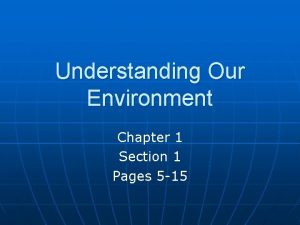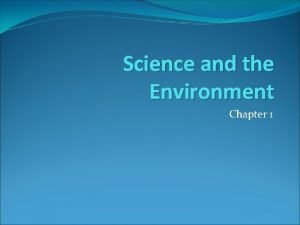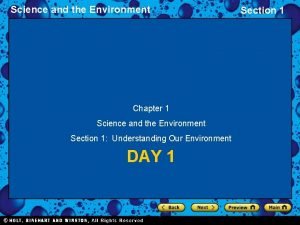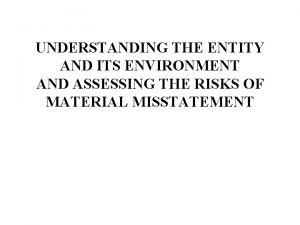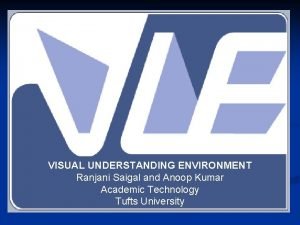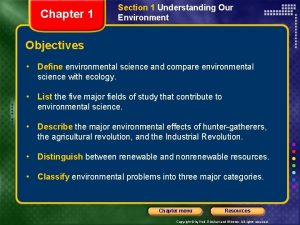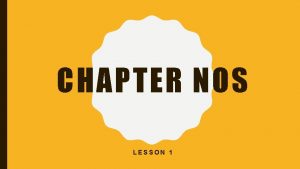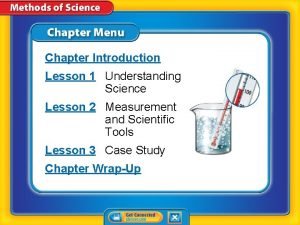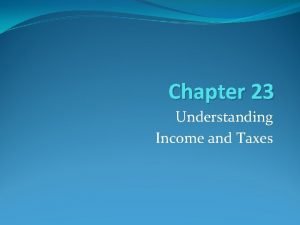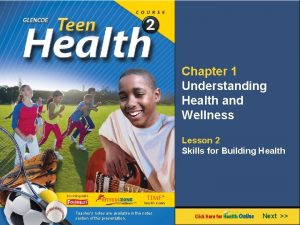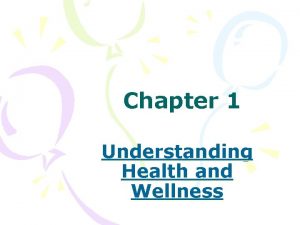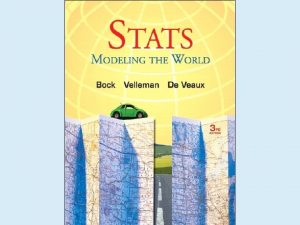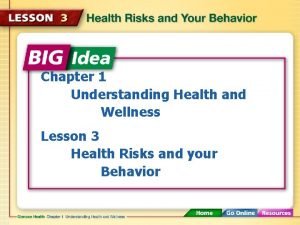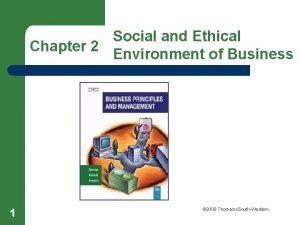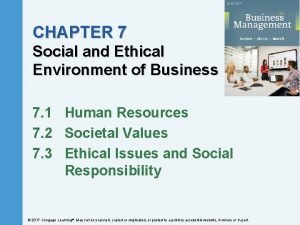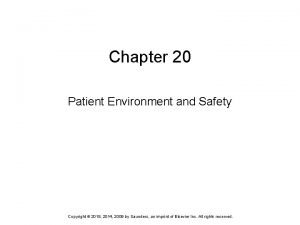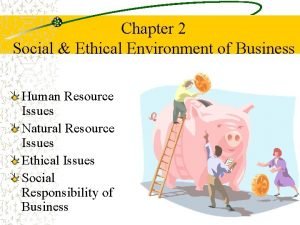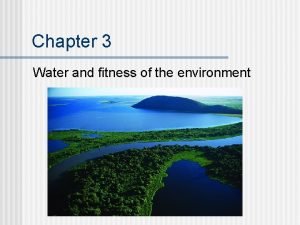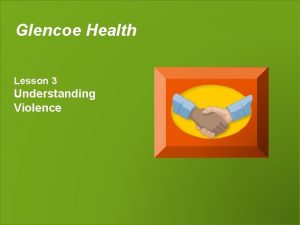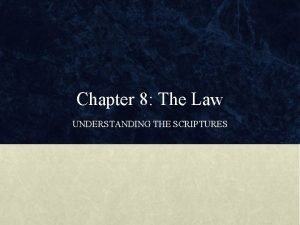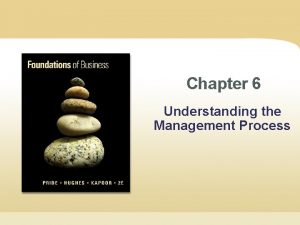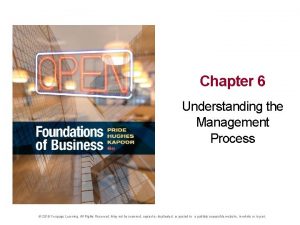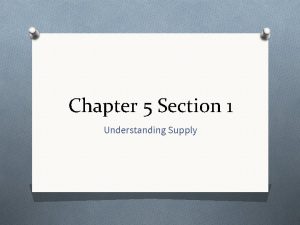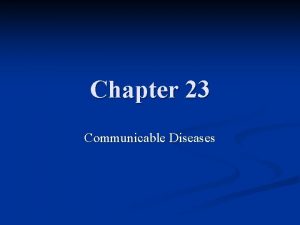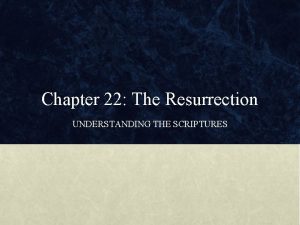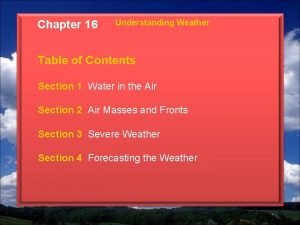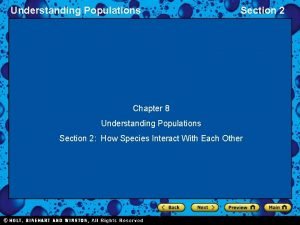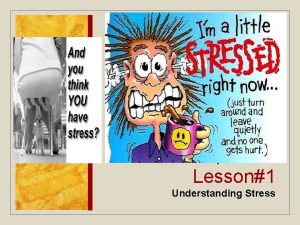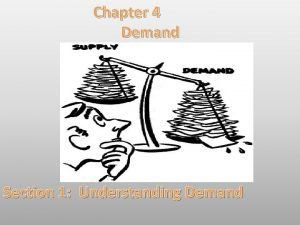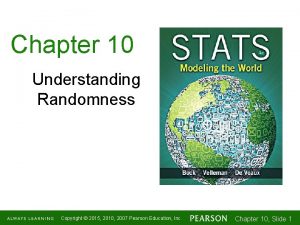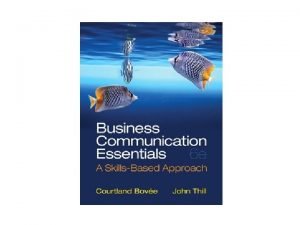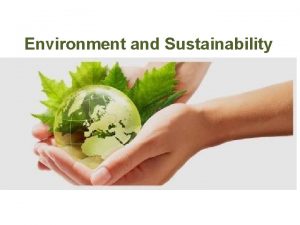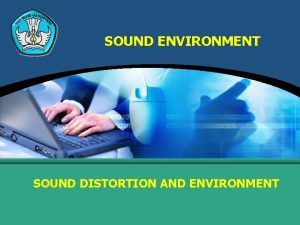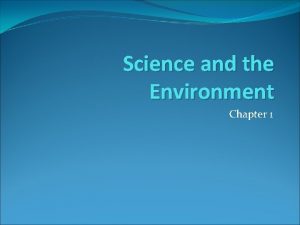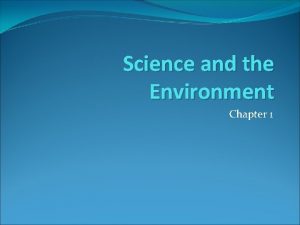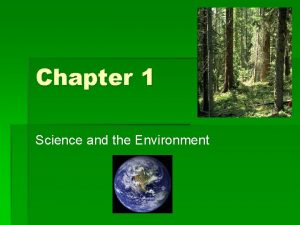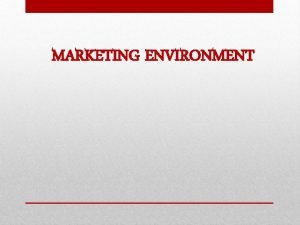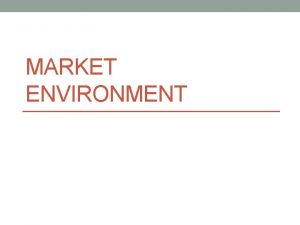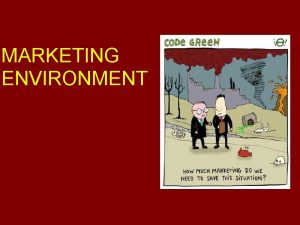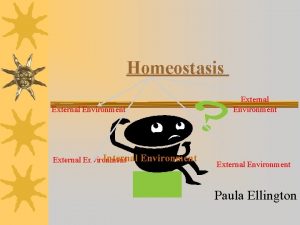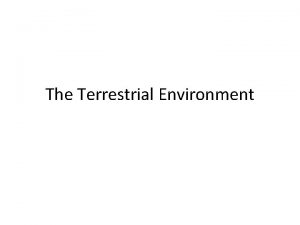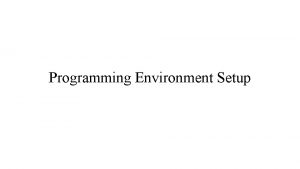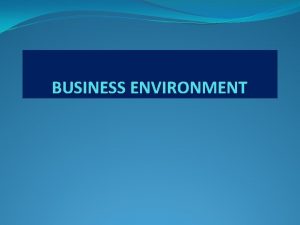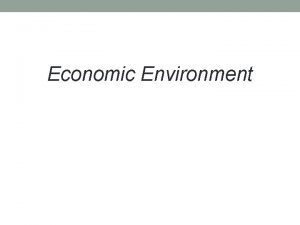Science and the Environment Chapter 1 Understanding the















































- Slides: 47

Science and the Environment Chapter 1

Understanding the Environment �Chapter 1, Section 1

What is an environment? �Class discussion: �What do you think of when you hear the word environment?

�Did anyone think of the environment in their own backyard?

What is the environment? �The environment is not only the landscape and animals that you can see, it is also how they interact

Environmental Science �Definition: �The study of how humans interact with the environment �Involves the following interactions between human and the environment: �How humans use natural resources �How human beings relate to the nonliving environment �How human actions alter the environment �(All of the above)

Environmental Science �What is studied in environmental science? �Interactions between living organisms and their nonliving environment �Impact of humans on the environment �Interaction between organisms �(All of the above)

The Goals of Environmental Science �To understand solve environmental problems �Do this in two ways: �Study how humans use natural resources �Study how our actions alter the environment

Environmental Science Studies Many Fields of Science �Ecology – The study of how living things interact with each other and with their nonliving environment

Fields Continued �Biology – the study of living organisms �Zoology – the study of animals �Botany – the study of plants �Microbiology – the study of microorganisms �Ecology - the study of the home

Fields Continued �Earth Science – the study of the Earth’s nonliving systems and the planet as a whole �Geology – the study of the Earth’s surface, interior processes, and history �Paleontology – the study of fossils and ancient life �Climatology – the study of the Earth’s atmosphere and climate �Hydrology – the study of the Earth’s water resources

Fields Continued �Physics – the study of matter and energy �Engineering – the science by which matter and energy are made useful to humans in structures, machines, and products

Fields Continued �Chemistry – the study of chemicals and their interactions �Biochemistry – the study of the chemistry of living things �Geochemistry – a branch of geology, is the study of the chemistry of materials such as rocks, soil, and waste

Fields Continued �Social Science – the study of human population �Geography – the study of the relationships between human populations and Earth’s features �Anthropology – the study of the interactions of the biological, cultural, geographical, and historical aspects of humankind �Sociology – the study of human population dynamics and statistics �NOT linguistics and physics (d)

Scientists as Citizens, Citizens as Scientists �Environmental Science starts with the non-scientists �What would you do if you came across a creature that looked like this?

Our Environment Through Time �Humans changed environment over time through: �Hunting �Agriculture �When they settled

Hunter-Gatherers �For most of history, people were hunter gatherers �They obtained food through: �Collecting plants �Hunting wild animals �Scavenging their remains �Humans lived in tribes, using fires to maintain the prairie �They would migrate as groups throughout the year to where resources were bountiful �Would you be willing to move every month to obtain food?

Early Environmental Problems �Native American tribes and Aborigines would burn down forests and grasslands to drive out animals such as Buffalo �They would carry plants with them where they traveled – invasive exotic species

Endangered Species �Led to extinction of mammals such as: �Giant bison �Mastodons �Cave Bears �Saber-Toothed Cats �Would trap in pits and then kill them

The Agricultural Revolution �Agriculture – the practice of growing, breeding, an caring for plants and animals that are used for food, clothing, housing, transportation, and other purposes. �It happened 10, 000 years ago �It had such an impact on humans that it became a revolution �Plants and animals were domesticated, human populations grew

�One area of land could now support up to 500 times the amount of people that could be supported by hunting and gathering �Communities began to grow �Population growth in the 20 th century led to �Resource depletion �Habitat destruction �Pollution �(all of the above)

�This agriculture changed the foods that we eat today �We eat descendents of the plants first found by hunters and gatherers �Over time, they picked desired traits in plants and began to only harvest those desired traits

�As environments were replaced by agriculture, they were destroyed �Slash-and-burn – cut down and burn old environments to plant crops – currently ocurring in rainforest

Industrial Revolution �Occurred in the middle of the 1700’s �Involved a shift from energy resources such as animal muscle and running water to fossil fuels �Allowed for machinery to take over in mass producing goods and agriculture �People began to travel more and move to cities �Society shifted to fossil fuels �When most of today’s environmental problems began answer C

Improving Quality of Life �Brought us things such as the light bulb and mass agriculture �Also brought us pollution and habitat loss

�Included the start of artificial substances in place of raw animal and plant products �Plastics, artificial pesticides and fertilizers, etc. �These products made our life easier, but what about the rest of the environment?

Spaceship Earth �Earth is a closed system �It is like a spaceship travelling through space that cannot dispose of waste or take on new supplies

�Problems occur on different scales: �Local �Regional �Global

Population Growth: A Local Pressure �Our population is growing faster than our resources can support �The Agricultural and Industrial Revolutions gave us power to grow much faster than before �Are we growing to fast?

What are the main environmental problems? �Resource Depletion �Pollution �Loss of Biodiversity

Resource Depletion �Natural Resource – Any natural material that is used by humans �Either renewable or nonrenewable �Renewable resources can be replaced quickly by natural processes �Nonrenewable resources - natural material formed at a slower rate than it is depleted �Resource Depletion - rate of resource use depletes resources and creates pollution and wastes

Depleted Resource �When a large fraction of the resource has been used up

Pollution �Pollution – an undesired change in air, water, or soil �Two types of pollutions �Biodegradable – pollutants that can be broken down by natural processes �Nondegradable – those that can’t – plastics, mercury, lead, etc.

Loss of Biodiversity �Biodiversity – the number of variety of species that live in an area �Extinction – a natural process �Mass Extinction – several extinctions happening at the same time �The loss of the worlds biodiversity is a concern because: �Humans depend on other organisms for food and oxygen

The Environment and Society �Chapter 1, Section 2

The Tragedy of the Commons �Garrett Hardin – 1968 �Describes conflicts associated with sharing resources �Commons are patches of grassland �If everyone lets too many sheep on the grasslands, they will destroy the environment �If people divide the commons and maintain the sheep population, the environment will survive �We need to do the same with our environment

The Law of Supply and Demand �The law of supply and demand describes: �Reduced demand resulting from lack of available resources

Market Equilibrium �Market Equilibrium - Listing both the merits and expenses involved in implementing a particular environmental solution

Economics and the Environment �Supply and Demand – the greater the demand for a limited supply of something, the more that thing is worth �Cost and Benefits – This balances the cost of the action against the benefits one expects from it (is an environmental action worth it? ) �Risk Assessment – A tool that helps us create costeffective ways to protect our health and the environment

Developed and Developing Countries �Developed Countries – characterized by high personal wealth, and high levels of consumption �Typically have a larger ecological footprint �Developing Countries – characterized by high population growth rate, extreme poverty

Population and Consumption �Local Population Pressures �Consumption Trends �Ecological Footprints

Local Population Pressures �Often, populations increase in developing nations �It increases faster than resources can be provided �Of the 4. 5 billion people in developing countries, fewer than half have access to enough food, safe drinking water, and proper sanitation

Consumption Trends �Population control, pollution depletion, and resource abundance has improved in the wealthier part of the world �This is only done by hogging the resources from developing countries that need them as well

Ecological Footprint �An ecological footprint shows the productive area of Earth needed to support one person in a particular country

Environmental Science in Context �Environmental problems are large �Simple answers are rare

Critical thinking and the Environment �Environmental Information is often construed by political pull or for sales �How to approach it: � 1. Be prepared to listen to many viewpoints �Understand their reasoning before reacting to their ideas �If you want your opinion to be heard, you must also be willing to listen to others � 2. Investigate the source of any information you encounter

A Sustainable World �The key goal of environmental science is to achieve sustainability �Sustainability – the condition in which human needs are met in such a way that a human population can survive indefinitely �This goal requires everyone’s participation �The 21 st Century is a critical time in finding sustainability �What will you do to make a change?
 Chapter 1 section 1 understanding our environment answers
Chapter 1 section 1 understanding our environment answers Chapter 1 science and the environment answer key
Chapter 1 science and the environment answer key Difference between ecology and environment
Difference between ecology and environment Chapter 1 science and the environment section 2
Chapter 1 science and the environment section 2 Understanding the entity and its environment
Understanding the entity and its environment It is my favourite subject
It is my favourite subject Visual understanding environment
Visual understanding environment Section 1 understanding our environment answer key
Section 1 understanding our environment answer key Environment of business finance
Environment of business finance Understanding science lesson 1 answer key
Understanding science lesson 1 answer key Lesson 2 measurement and scientific tools answer key
Lesson 2 measurement and scientific tools answer key Understanding science lesson 1 answer key
Understanding science lesson 1 answer key Chapter 23 understanding income and taxes
Chapter 23 understanding income and taxes Understanding your health and wellness chapter 1
Understanding your health and wellness chapter 1 Chapter 1 understanding your health and wellness
Chapter 1 understanding your health and wellness Understanding your health and wellness
Understanding your health and wellness Chapter 1 understanding health and wellness lesson 4
Chapter 1 understanding health and wellness lesson 4 Glencoe health chapter 1 understanding health and wellness
Glencoe health chapter 1 understanding health and wellness Chapter 1 lesson 2 what affects your health
Chapter 1 lesson 2 what affects your health Understanding health and wellness
Understanding health and wellness Understanding health and wellness
Understanding health and wellness Chapter 5 understanding and comparing distributions answers
Chapter 5 understanding and comparing distributions answers Chapter 1 understanding health and wellness lesson 3
Chapter 1 understanding health and wellness lesson 3 Natural science and social science similarities
Natural science and social science similarities Science fusion digital lessons
Science fusion digital lessons Hard and soft science
Hard and soft science Chapter 2 social and ethical environment of business
Chapter 2 social and ethical environment of business Chapter 7 social and ethical environment of business
Chapter 7 social and ethical environment of business Patient environment and safety
Patient environment and safety Chapter 2 social and ethical environment of business
Chapter 2 social and ethical environment of business Chapter 3 water and the fitness of the environment
Chapter 3 water and the fitness of the environment Chemistry central science 14th edition
Chemistry central science 14th edition Chapter 9 lesson 3 understanding violence
Chapter 9 lesson 3 understanding violence Understanding the scriptures chapter 24 study questions
Understanding the scriptures chapter 24 study questions Chapter 6 understanding the management process
Chapter 6 understanding the management process Understanding the management process
Understanding the management process Section 1 understanding supply
Section 1 understanding supply Chapter 23 lesson 2 common communicable diseases
Chapter 23 lesson 2 common communicable diseases Understanding the scriptures chapter 22 study questions
Understanding the scriptures chapter 22 study questions Understanding the scriptures chapter 20 study questions
Understanding the scriptures chapter 20 study questions Chapter 16 understanding weather answer key
Chapter 16 understanding weather answer key Chapter 8 understanding populations
Chapter 8 understanding populations Chapter 4 lesson 1 understanding stress
Chapter 4 lesson 1 understanding stress Chapter 4 section 1 understanding demand
Chapter 4 section 1 understanding demand Chapter 10 understanding randomness
Chapter 10 understanding randomness Understanding human communication 14th edition chapter 1
Understanding human communication 14th edition chapter 1 Chapter 1 understanding business communication
Chapter 1 understanding business communication Business essentials 12th edition free
Business essentials 12th edition free
